Today, we take for granted that astronauts and cosmonauts work together aboard the International Space Station, and have been doing so for 20 years. But it wasn’t always that way. During the Cold War in the 1960s and early 1970s, meetings between American astronauts and then-Soviet cosmonauts were rare events, often taking place when they happened to be attending the same international venue such as a scientific conference. President Richard M. Nixon’s space policy encouraged cooperation with other nations, including the Soviet Union. Thus began a series of astronaut and cosmonaut visits, beginning with Frank Borman’s trip to the USSR in July 1969, reciprocated with the visit of Georgi T. Beregovoi and Konstantin P. Feoktistov to the United States the following October. In May-June 1970, it was Neil A. Armstrong’s turn to take a goodwill tour of the USSR. While he visited the Gagarin Cosmonaut Training Center in Star City outside Moscow, the Soviets launched Andriyan G. Nikolayev and Vitali I. Sevastyanov aboard Soyuz 9 on a record-setting 18-day mission. Four months after their return to Earth, Nikolayev and Sevastyanov spent 10 days on a goodwill tour of the United States. While they toured the U.S., a NASA delegation met with their Soviet counterparts in Moscow to discuss possible future cooperation in human spaceflight, the initial step that led to the first joint docking in space less than five years later.
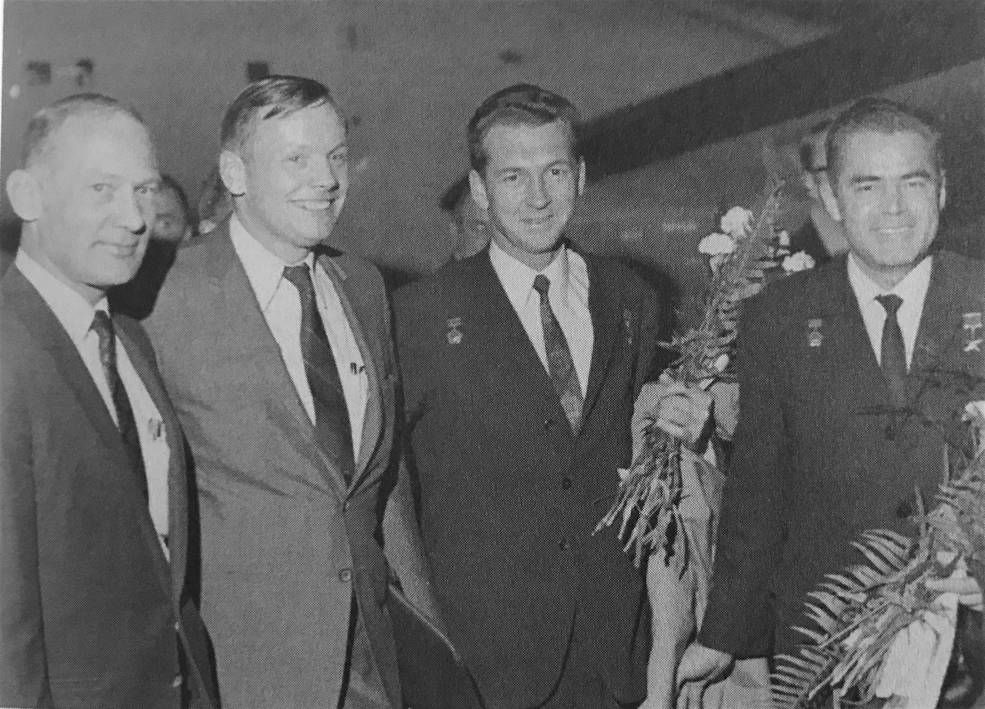
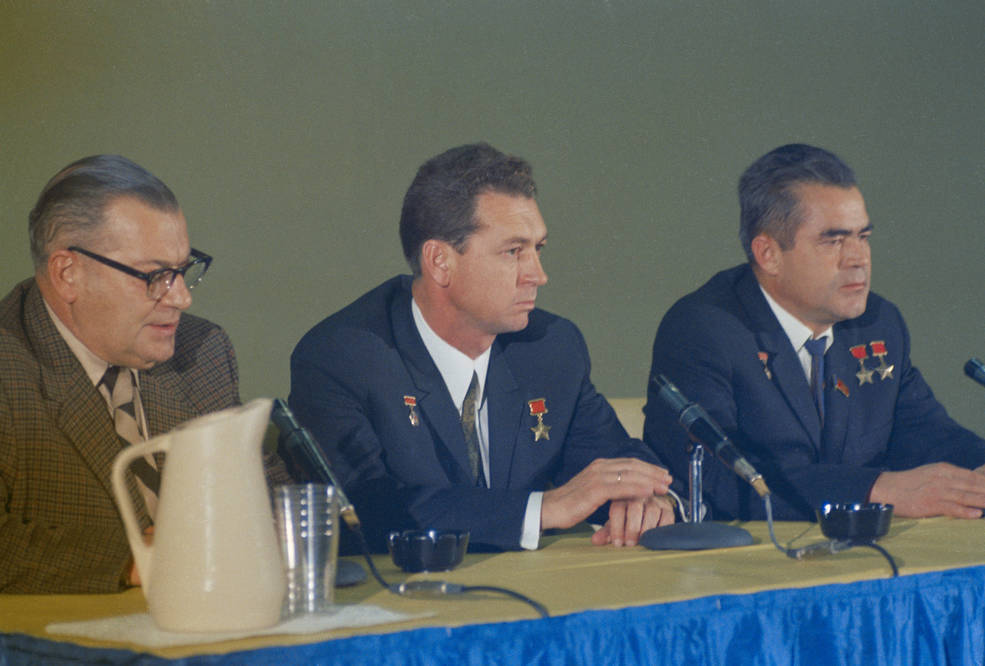
Left: Apollo 11 astronauts Edwin E. “Buzz” Aldrin, left, and Neil A. Armstrong with Soyuz 9 cosmonauts Vitali I. Sevastyanov and Andriyan G. Nikolayev upon their arrival at Washington D.C.’s National Airport. Right: With the aid of interpreter Ivan K. Shklyar, left, Sevastyanov and Nikolayev hold a press conference at NASA Headquarters in Washington, DC.
At NASA’s invitation, Nikolayev and Sevastyanov arrived in the United States on Oct. 18, 1970, landing in New York where Apollo 11 astronauts Neil A. Armstrong and Edwin E. “Buzz” Aldrin met them. They immediately boarded a plane bound for Washington, D.C.’s, National Airport, where NASA Acting Administrator George M. Low welcomed them on behalf of the agency. During their two-day stay in the nation’s capital, Nikolayev and Sevastyanov, with Aldrin acting as a tour guide, visited the Smithsonian Institution’s Aviation and Space Museum, the Jefferson and Lincoln Memorials, the Washington Monument, the Capitol, Mount Vernon, and Arlington National Cemetery where they laid wreaths at the graves of Apollo 1 astronauts Virgil I. Grissom and Roger B. Chaffee. At NASA Headquarters, the two cosmonauts gave a press conference, answering assembled reporters’ questions about their historic spaceflight and the Soviet Union’s future plans in space.
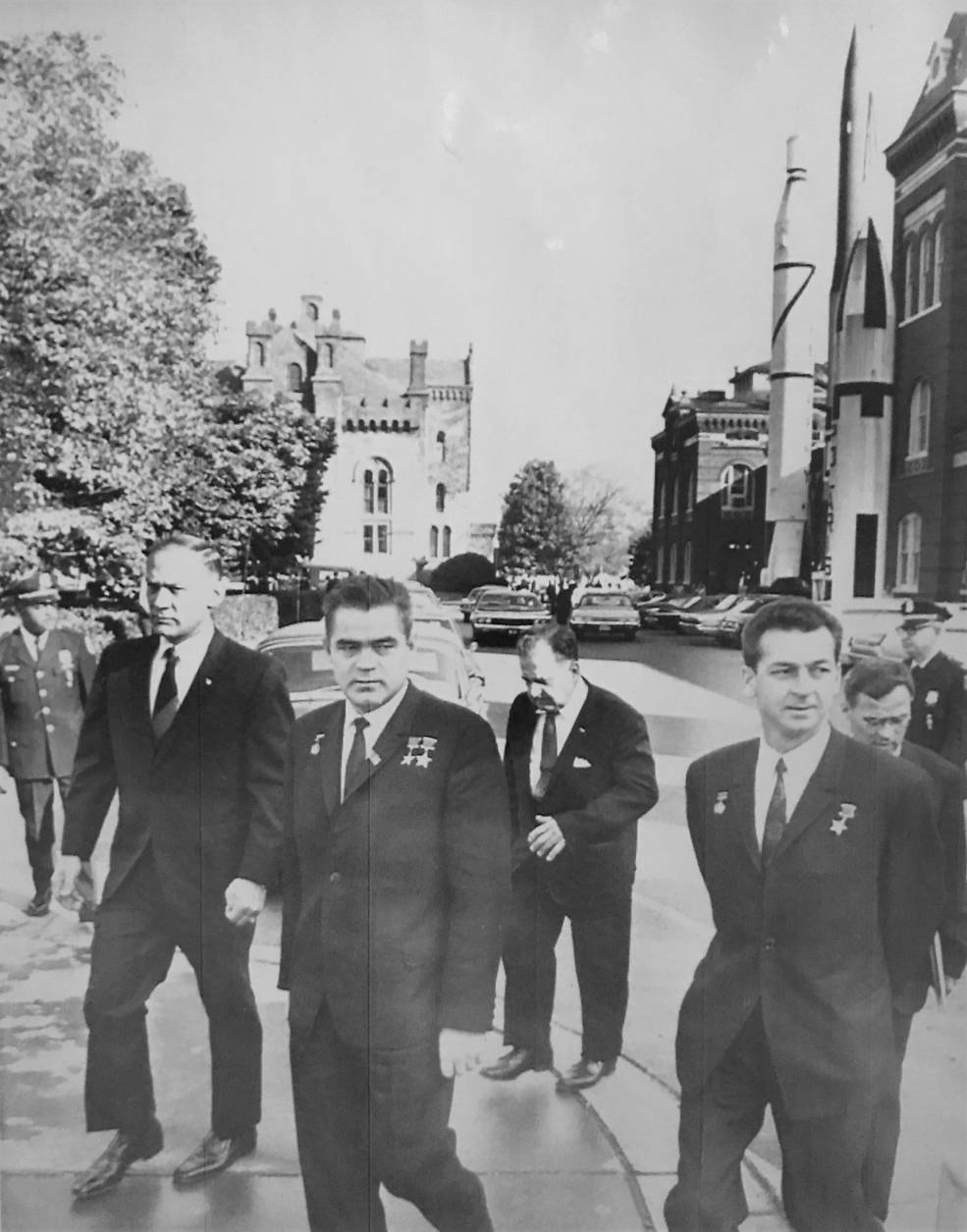
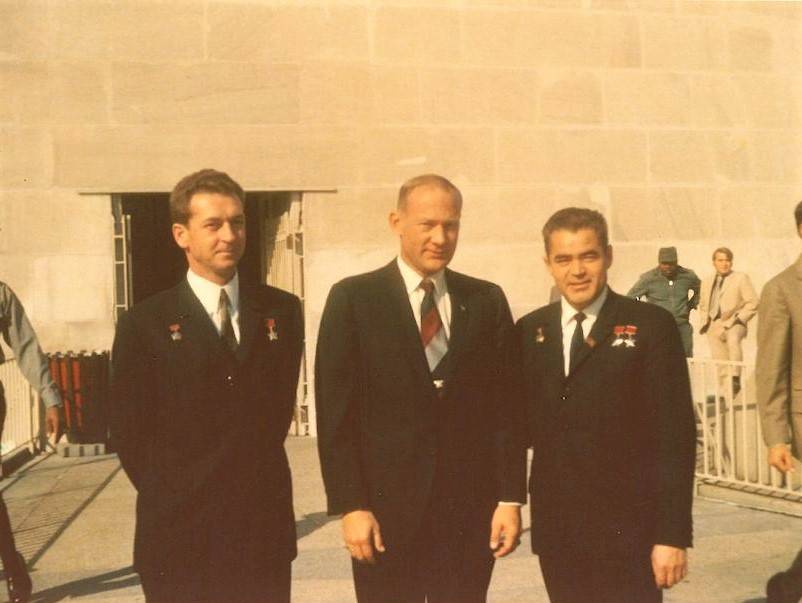
Left: NASA astronaut Edwin E. “Buzz” Aldrin, left, with cosmonauts Andriyan G. Nikolayev and Vitali I. Sevastyanov outside the Smithsonian Institution’s Aviation and Space Museum in Washington, D.C. Right: Sevastyanov, left, Aldrin, and Nikolayev at the Washington Monument.
From Washington, D.C., on Oct. 20, Nikolayev, Sevastyanov, and Aldrin traveled to Huntsville, Alabama, where they visited NASA’s Marshall Space Flight Center and toured the Alabama Space and Rocket Center. One of the highlights at Marshall included Sevastyanov donning an Apollo A7L extravehicular training suit and joining NASA astronaut Russell L. “Rusty” Schweickart in the Neutral Buoyancy Simulator (NBS) for a practice spacewalk. Astronauts used the NBS, a 75-foot diameter and 40-foot deep pool, to simulate tasks for extravehicular activities or EVAs. Although at the time Soviet cosmonauts didn’t utilize neutral buoyancy to simulate spacewalks, Sevastyanov performed remarkably well on his first attempt, spending about 30 minutes in the pool simulating changing film canisters in a mockup of the Skylab space station’s Apollo Telescope Mount. He was so impressed that upon his return to the Soviet Union, his enthusiastic descriptions of the NBS training session may have led managers to design and build the Hydrolab facility at the Gagarin Cosmonaut Training Facility, with nearly identical dimensions to the pool at Marshall.

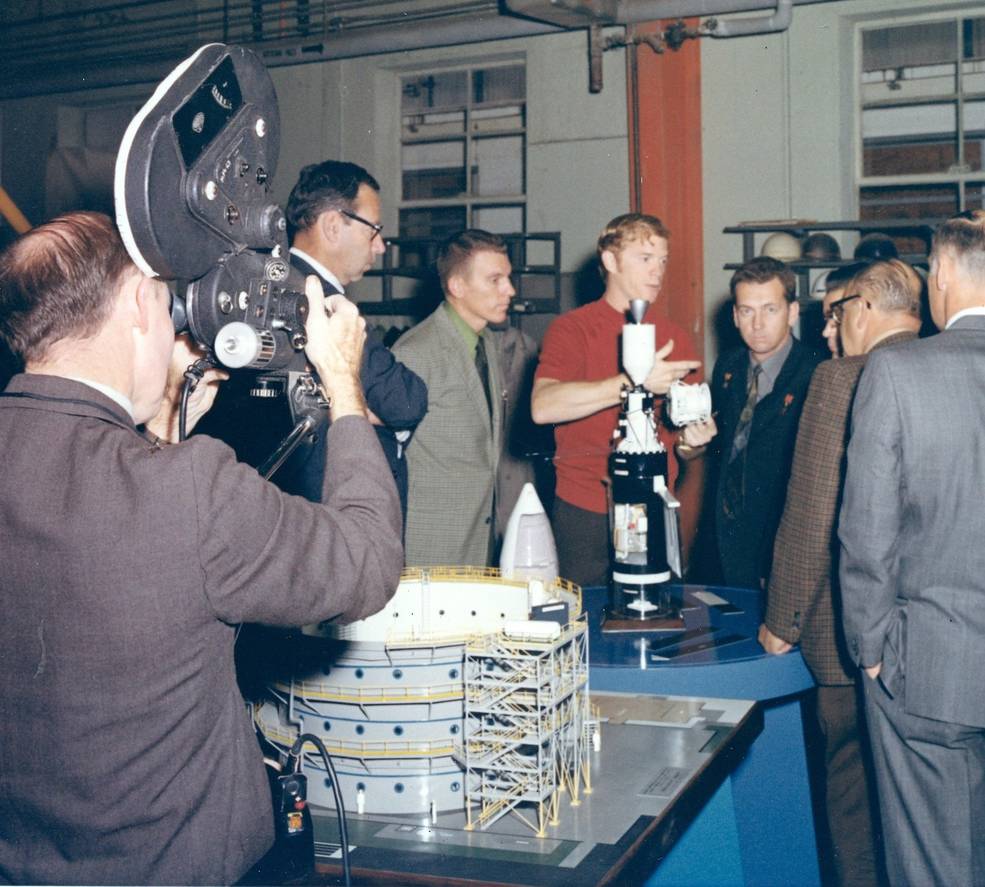
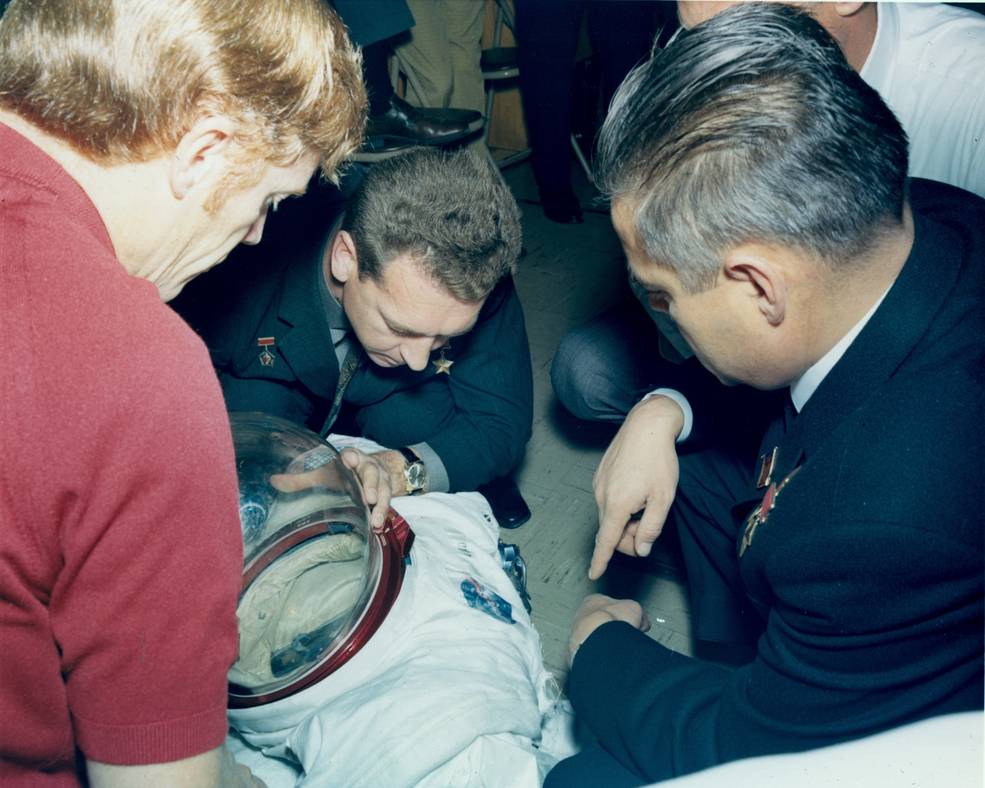
Left: Engineers at NASA’s Marshall Space Flight Center brief Andriyan G. Nikolayev and Vitali I. Sevastyanov on the Neutral Buoyancy Simulator (NBS), using a model of the facility. Middle: Russell L. “Rusty” Schweickart, in red shirt, describes a model of the Skylab space station to Sevastyanov and Nikolayev; the model of the NBS is visible in the foreground. Schweickart, left, Sevastyanov, and Nikolayev examine the Apollo A7L spacesuit at the NBS.

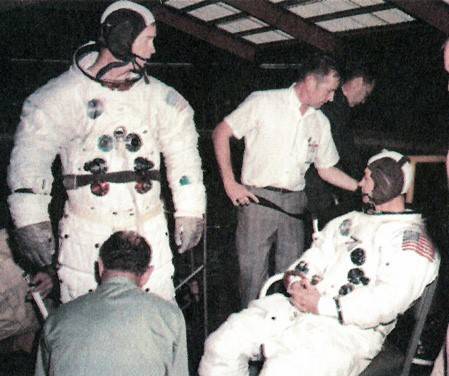
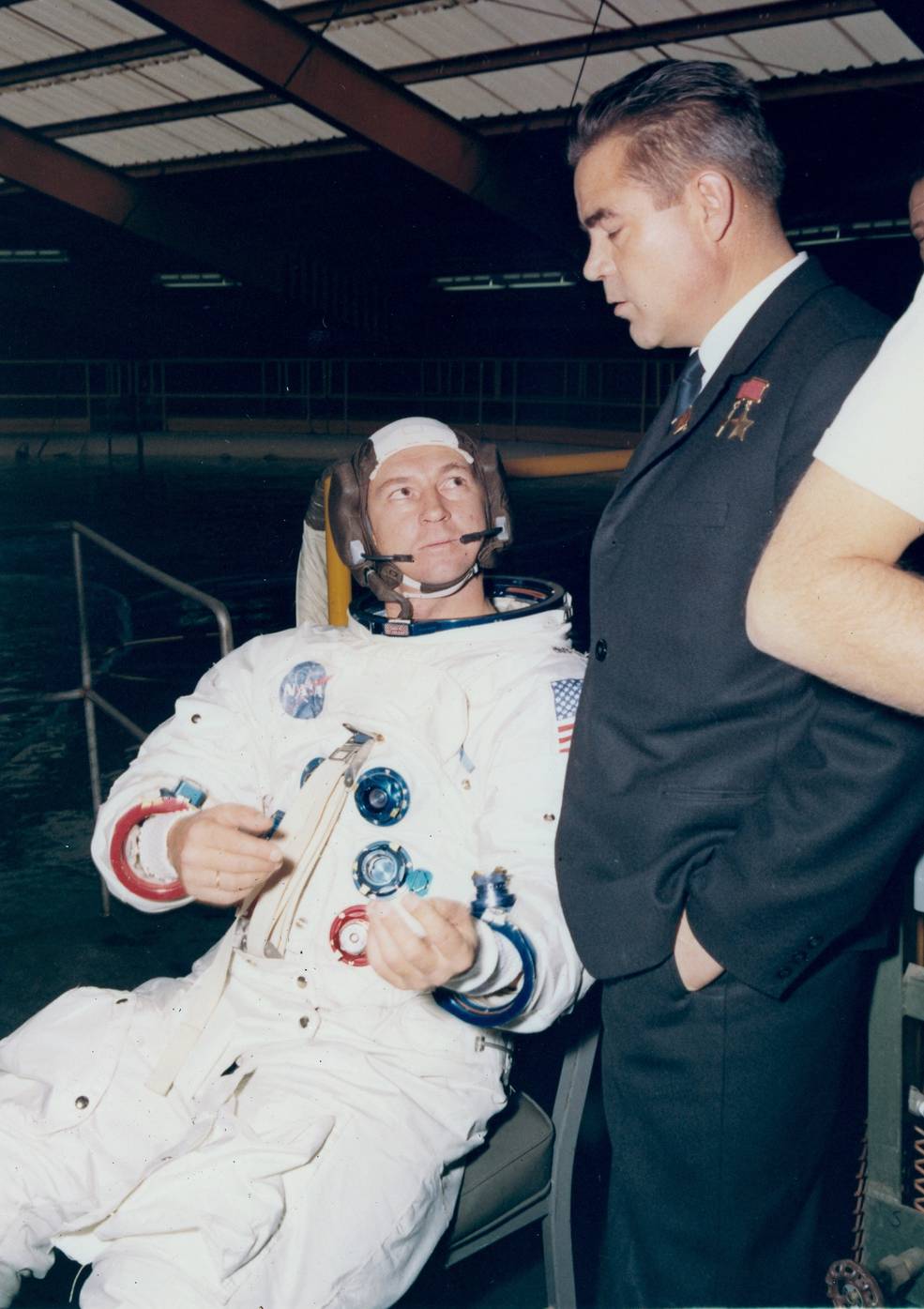
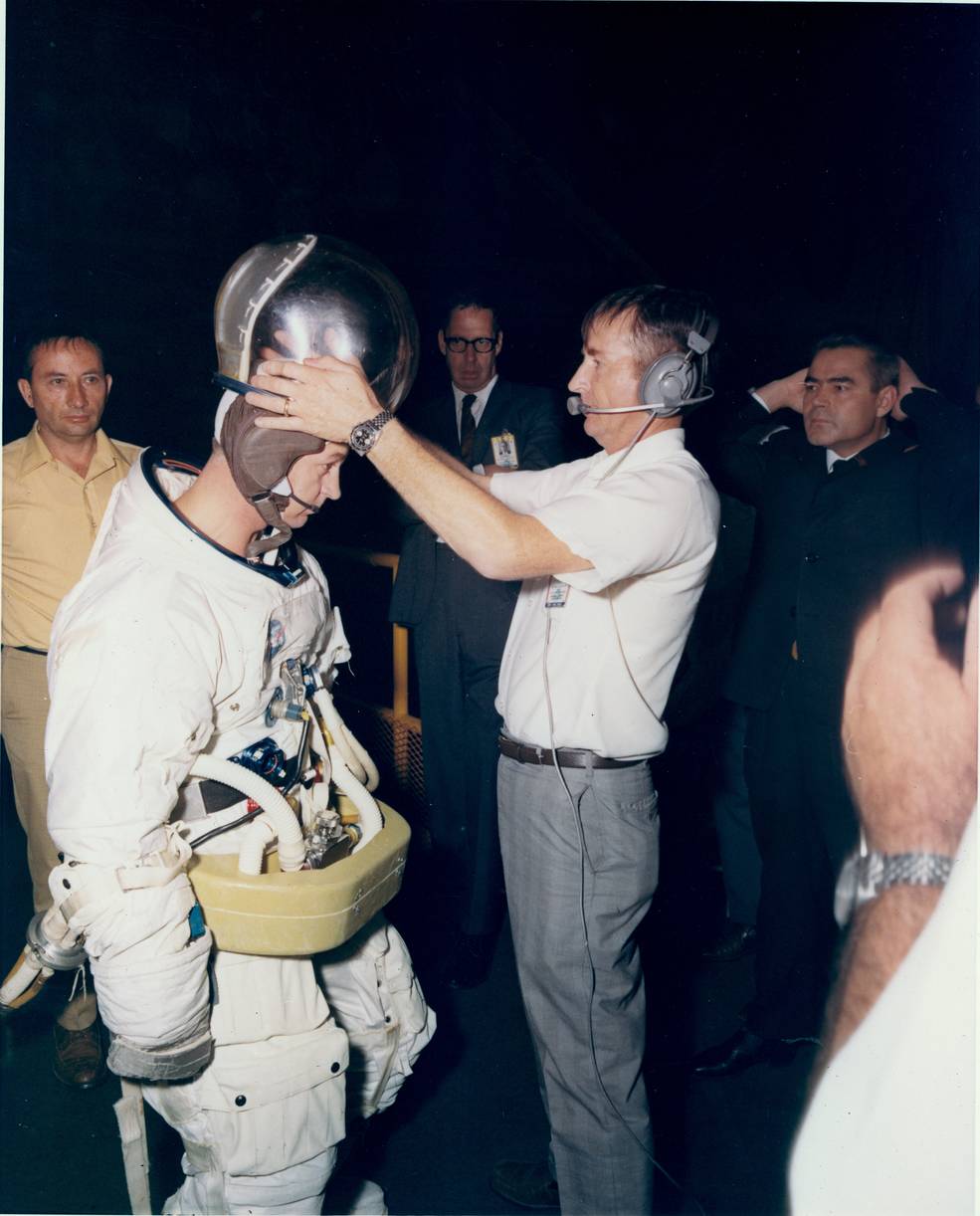
Left: Russell L. “Rusty” Schweickart, left, and Vitali I. Sevastyanov wearing the A7L spacesuits in preparation for the simulation in the Neutral Buoyancy Simulator (NBS) at NASA’s Marshall Space Flight Center. Middle left: Schweickart, left, and Sevastyanov prepare for the underwater run in the NBS. Middle right: Sevastyanov, left, confers with Andriyan G. Nikolayev during the suiting up process. Right: Technician lowers the A7L spacesuit’s helmet onto Sevastyanov.
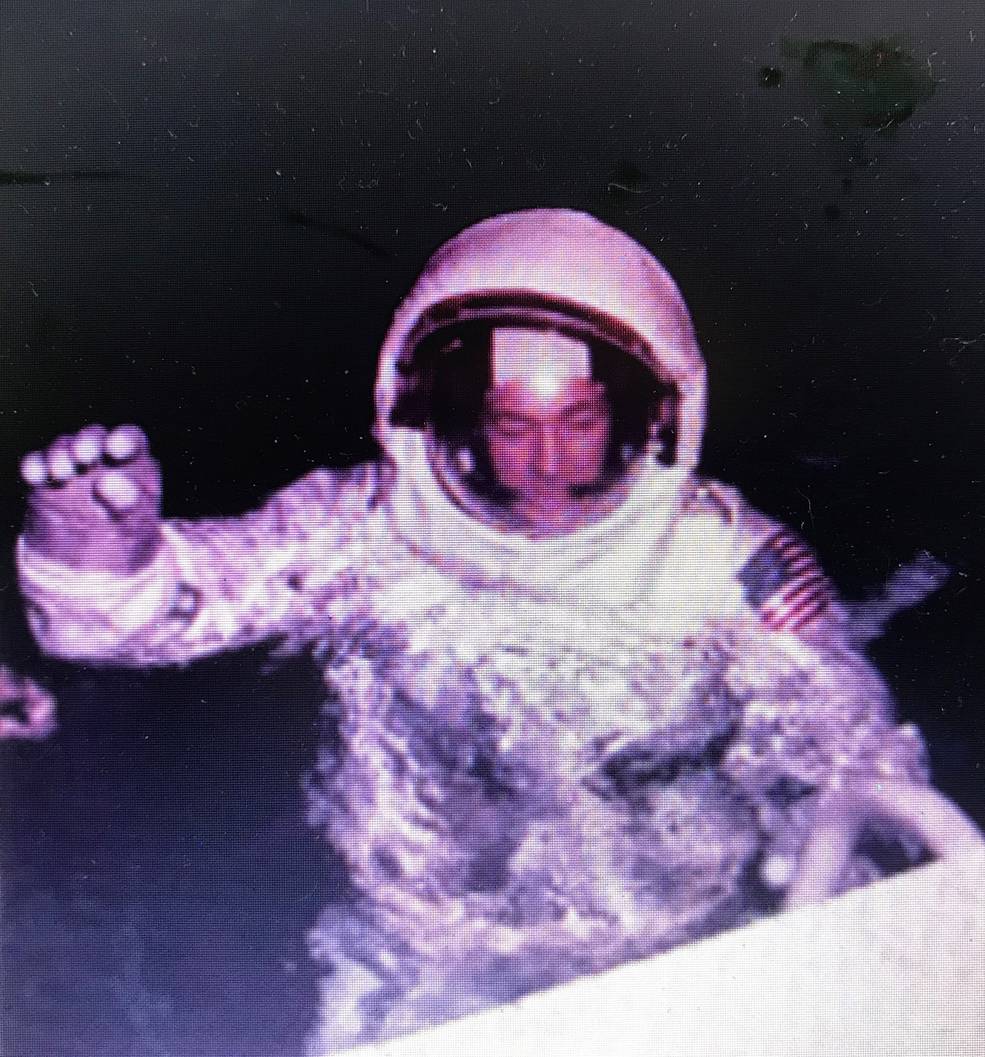
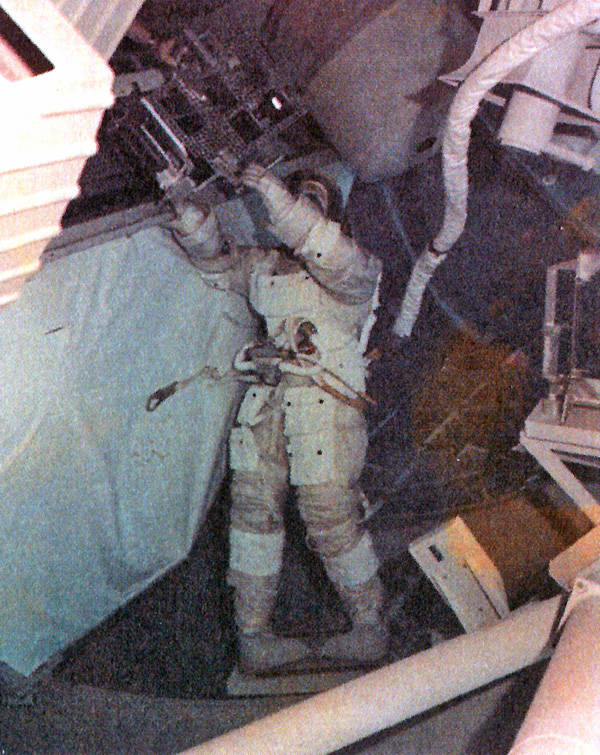
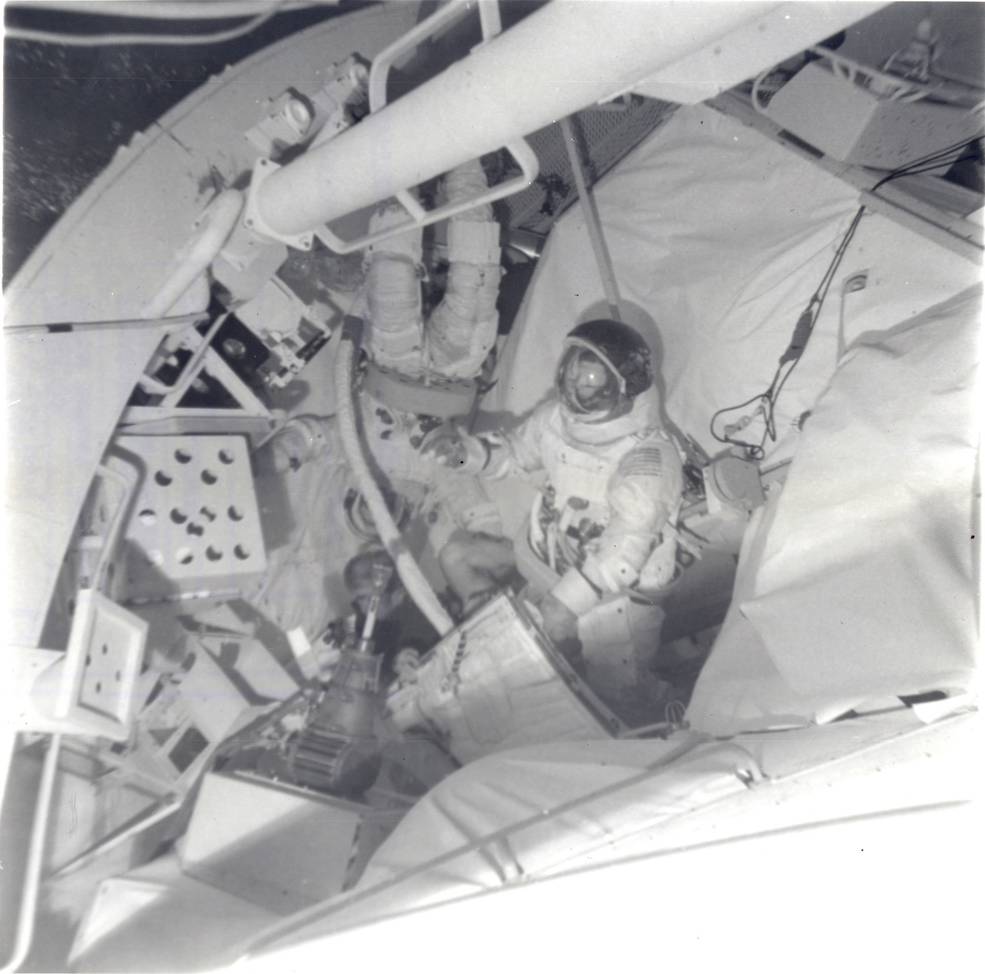
Left: Vitali I. Sevastyanov entering the water at the Neutral Buoyancy Simulator (NBS) at NASA’s Marshall Space Flight Center. Middle: Sevastyanov during the underwater run in the NBS. Right: Sevastyanov, left, and Russell L. “Rusty” Schweickart during the simulation in the NBS.
The next stop on the goodwill tour after Huntsville was Houston. Nikolayev, Sevastyanov, and Aldrin arrived by a NASA plane, landing at Ellington Air Force Base on Oct. 21, where an enthusiastic crowd greeted them. On the apron nearby sat a T-38 Talon training aircraft that Nikolayev and Sevastyanov eagerly examined, up close and personal from the cockpit. The next day they attended the 7th annual meeting of the American Institute of Aeronautics and Astronautics (AIAA) at the Astroworld Convention Hall, during which they gave a presentation about their record-setting mission. They attended an event at the Harris County Domed Stadium, also known as the Astrodome, and in the evening were guests at the AIAA banquet. NASA astronaut James A. McDivitt and his wife Patricia hosted a more informal affair at their home, attended by numerous astronauts and their wives, with Nikolayev and Sevastyanov as the guests of honor. On Oct 23, the two cosmonauts toured the Manned Spacecraft Center (MSC), now NASA’s Johnson Space Center, visiting the Mission Control Center, practicing a docking in the Apollo simulator with a target that astronauts had altered with a “USSR” label, receiving a demonstration of the Apollo A7L spacesuit, sampling astronaut meals in the Food Laboratory, and exchanging gifts with several astronauts.
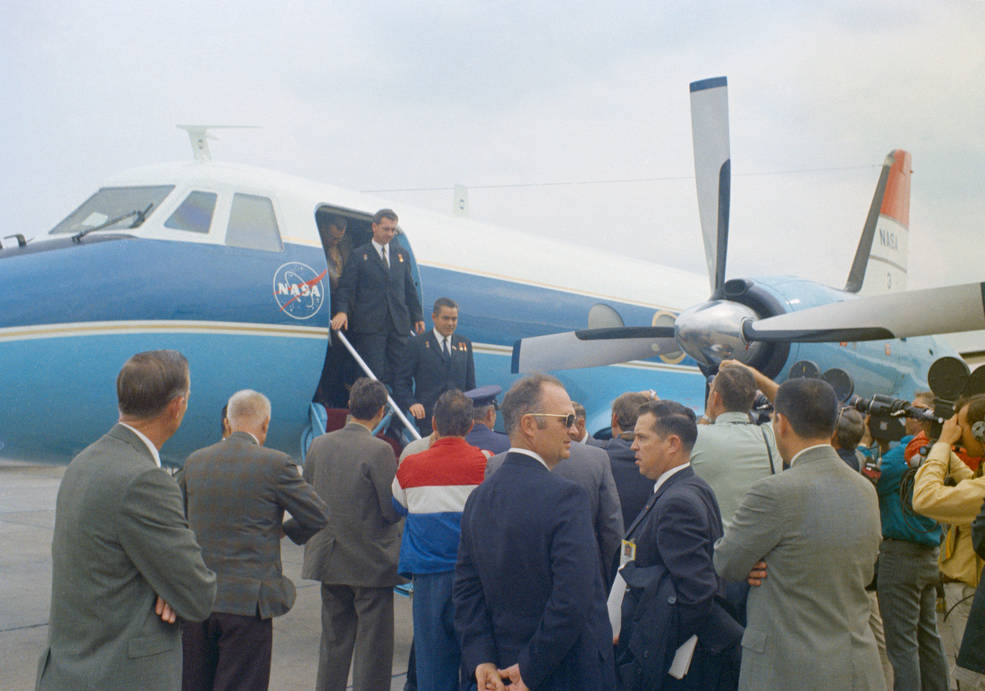
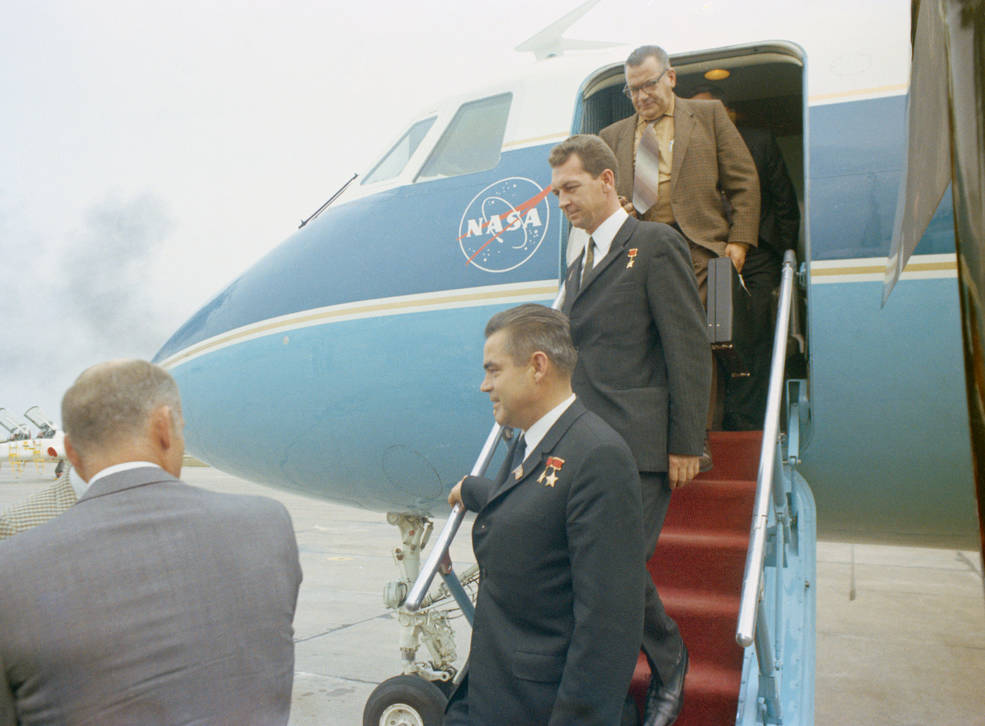
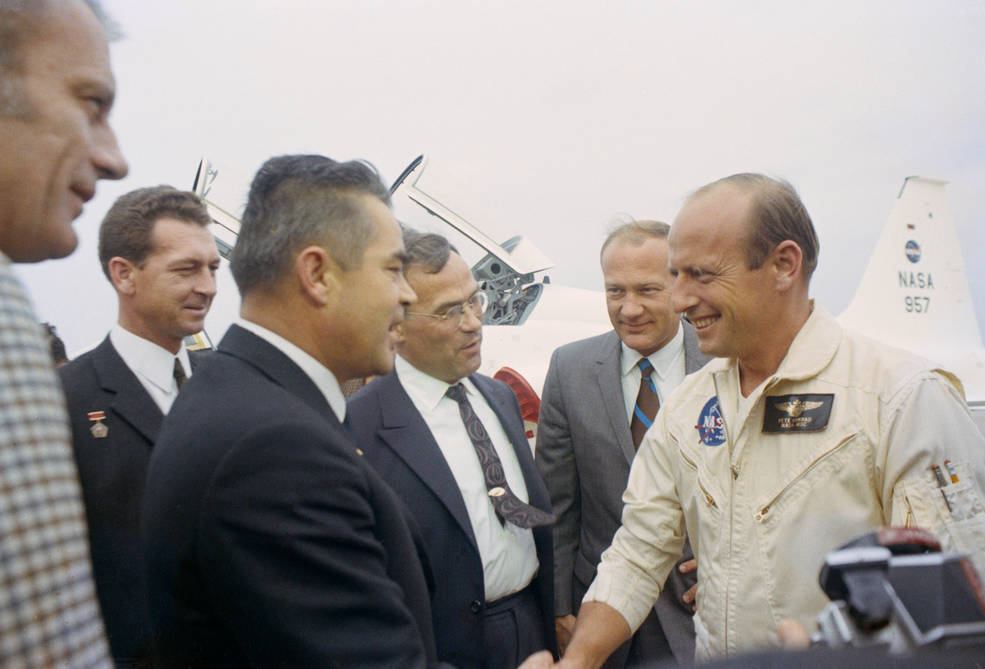
Left: A crowd of well-wishers greets Soyuz 9 cosmonauts Andriyan G. Nikolayev and Vitali I. Sevastyanov upon their arrival at Ellington Air Force Base (AFB) in Houston. Middle: Nikolayev, left, and Sevastyanov deplaning at Ellington AFB. Right: Astronauts and cosmonauts meet at Ellington AFB – Donald K. “Deke” Slayton, left, Sevastyanov, Nikolayev, interpreter, Edwin E. “Buzz” Aldrin, and Charles “Pete” Conrad.
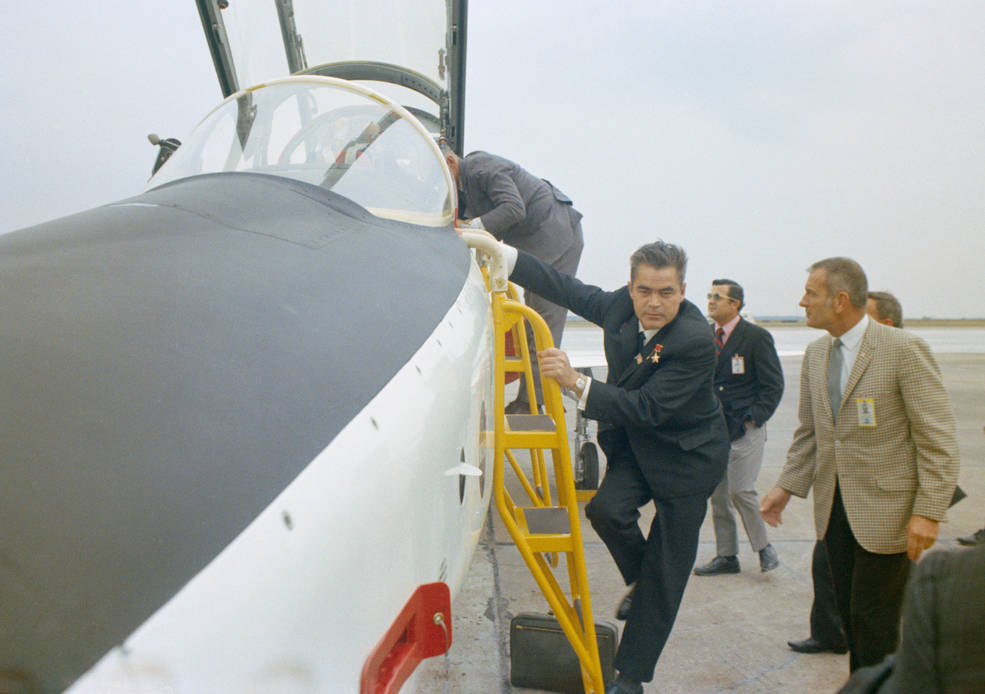
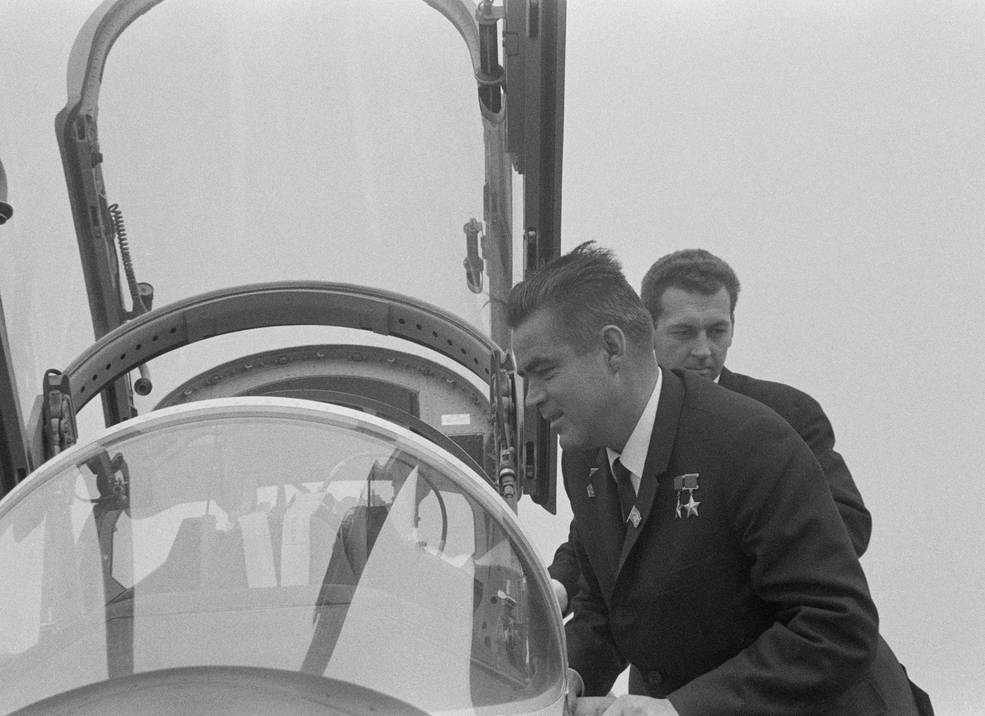
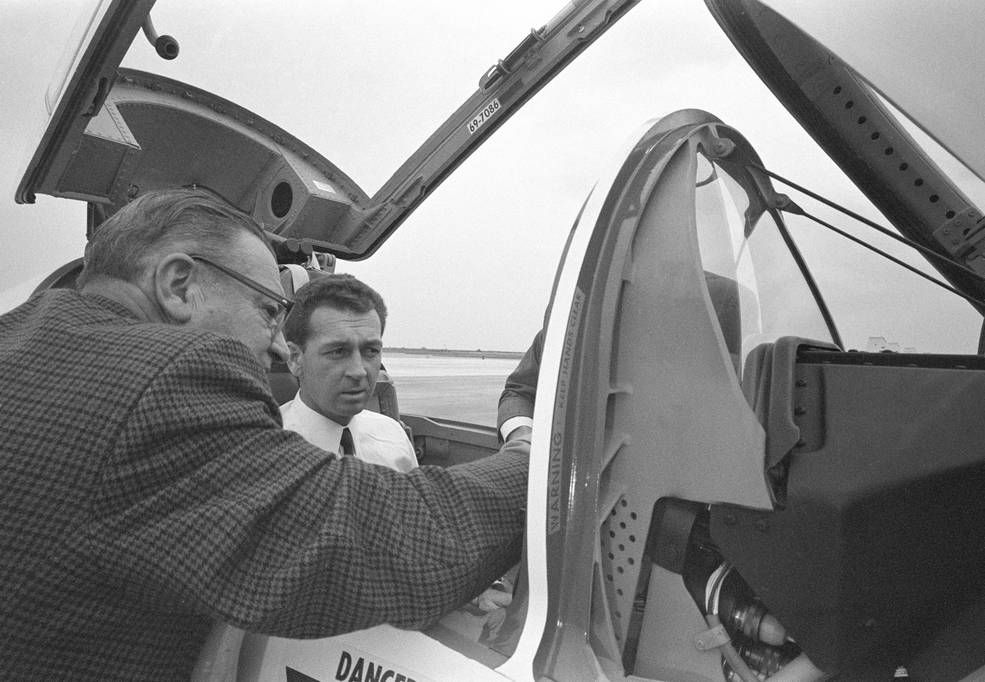
Left: Andriyan G. Nikolayev mounts the ladder to examine a T-38 Talon training aircraft at Ellington Air Force Base in Houston. Middle: Nikolayev examines the cockpit of the T-38. Right: Vitali I. Sevastyanov receives a briefing while sitting in the T-38 cockpit.
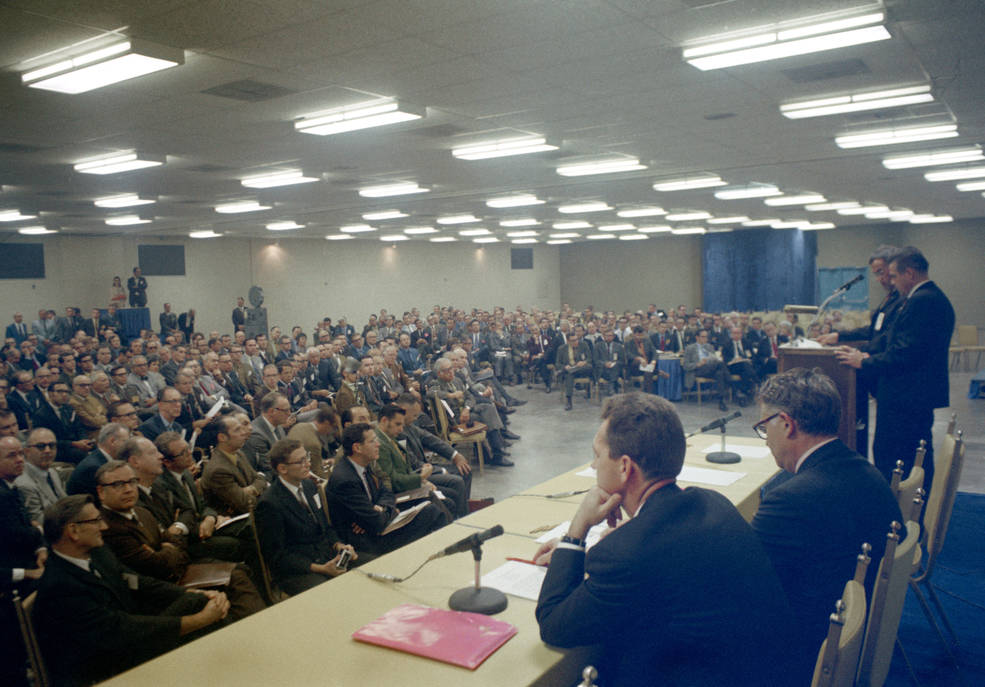
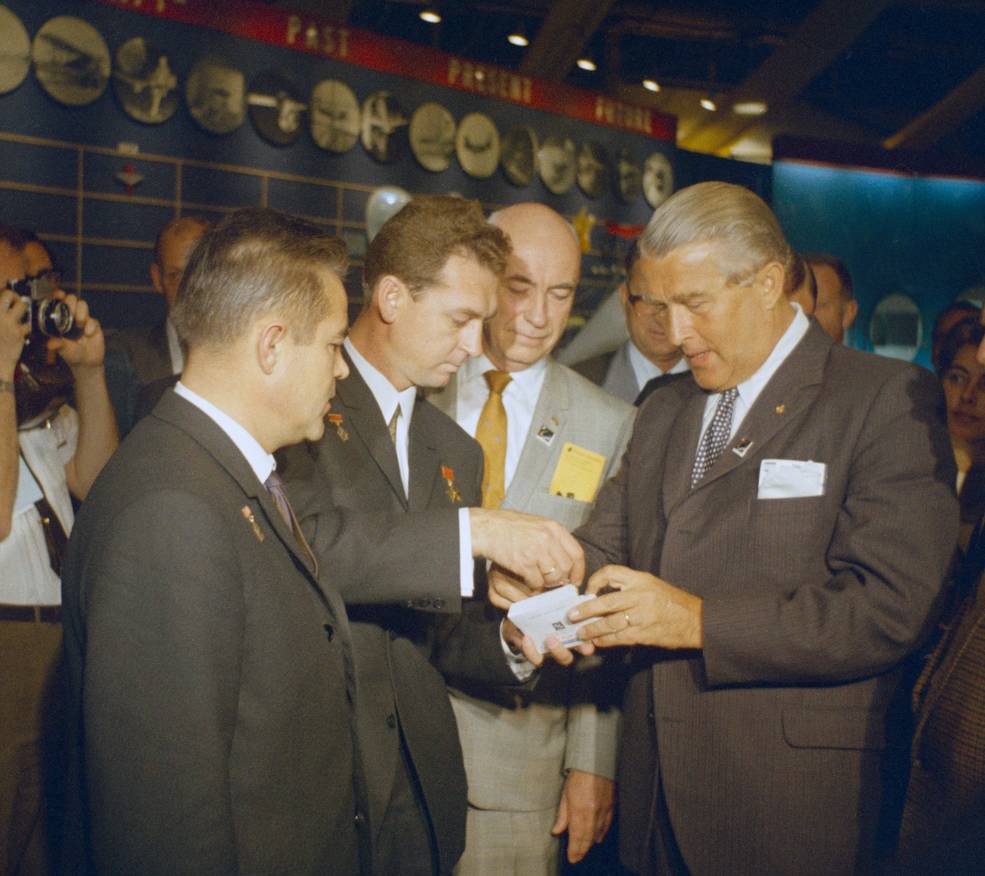
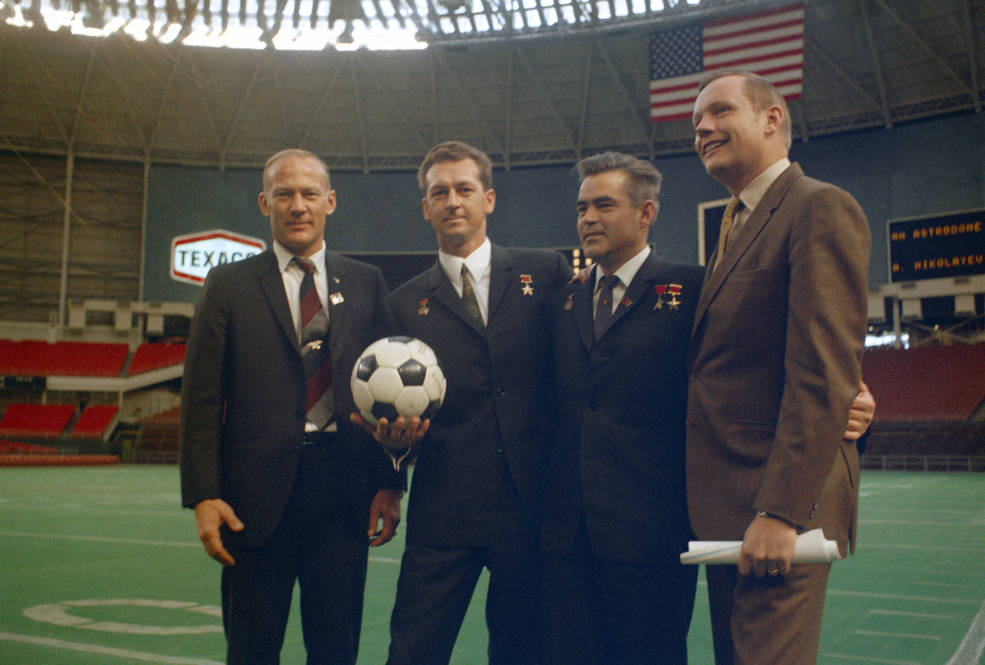
Left: Vitali I. Sevastyanov, seated at left, and Andriyan G. Nikolayev, standing at podium, presenting their papers at the 7th annual meeting of the American Institute of Aeronautics and Astronauts (AIAA) in Houston. Middle: At the AIAA meeting, Nikolayev, left, and Sevastyanov chat with Manned Spacecraft Center Director Robert R. Gilruth and former Marshall Space Flight Center Director Wernher von Braun. Right: Edwin E. “Buzz” Aldrin, left, Sevastyanov, Nikolayev, and Neil A. Armstrong at the Astrodome in Houston.
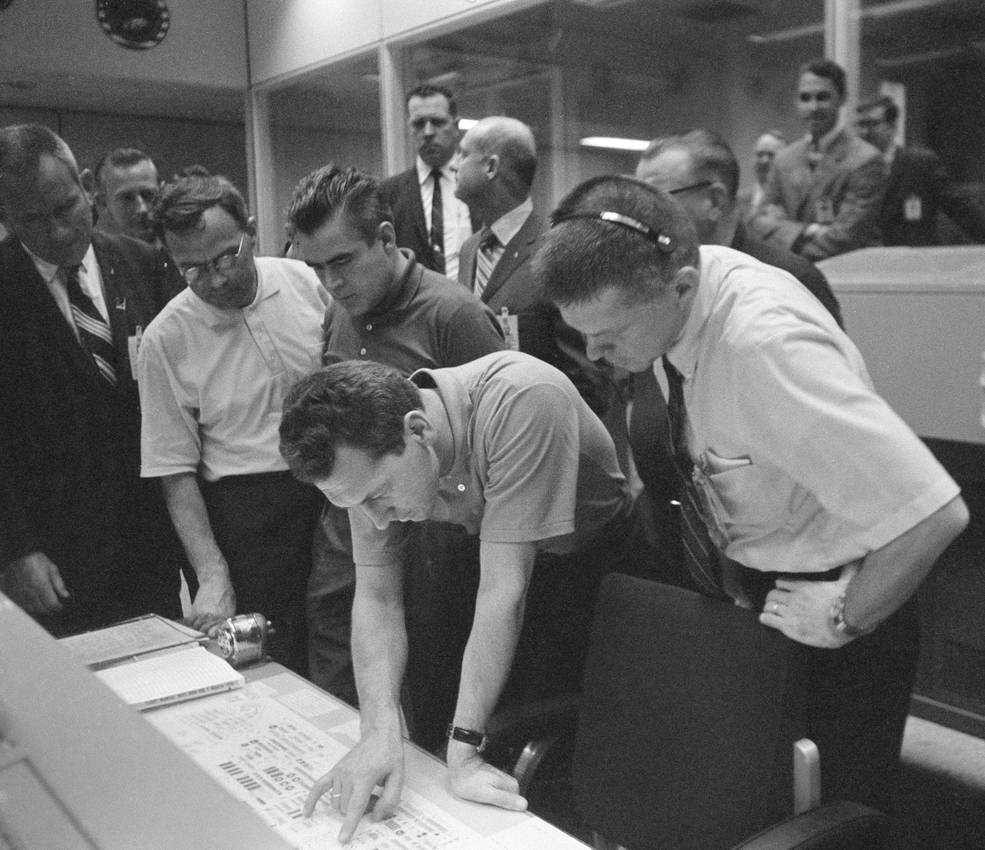
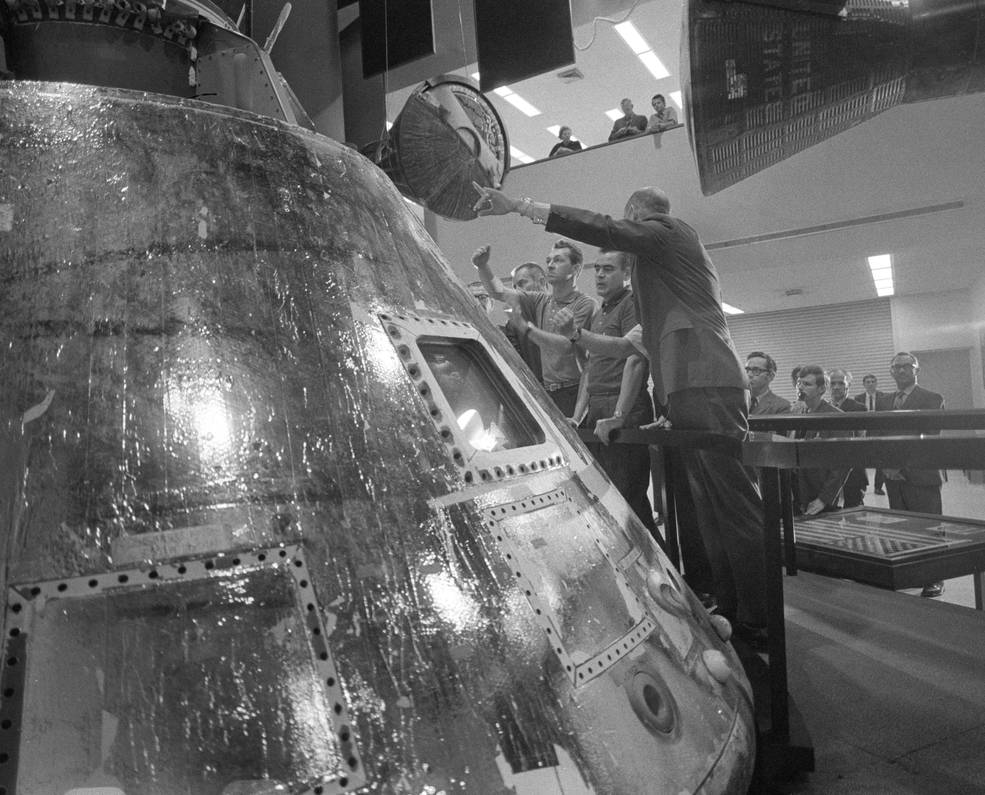
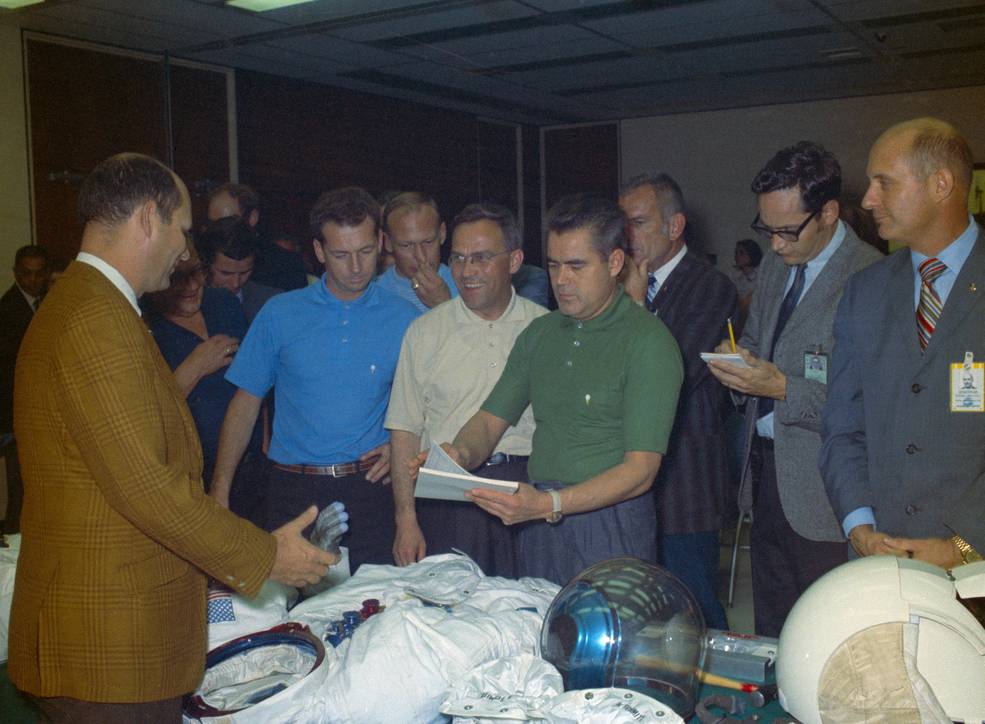
Left: Vitali I. Sevastyanov, second from right, examines documents in the Mission Control
Center as Andriyan G. Nikolayev and Flight Director M.P. “Pete” Frank look on.
Middle: Thomas P. Stafford, right, points out features of the Apollo 9 Command Module
to Sevastyanov and Nikolayev. Right: Crew Systems Division Chief R.E. Smylie, left,
points out features of the Apollo spacesuit to Sevastyanov, in blue shirt, and
Nikolayev, in green shirt.
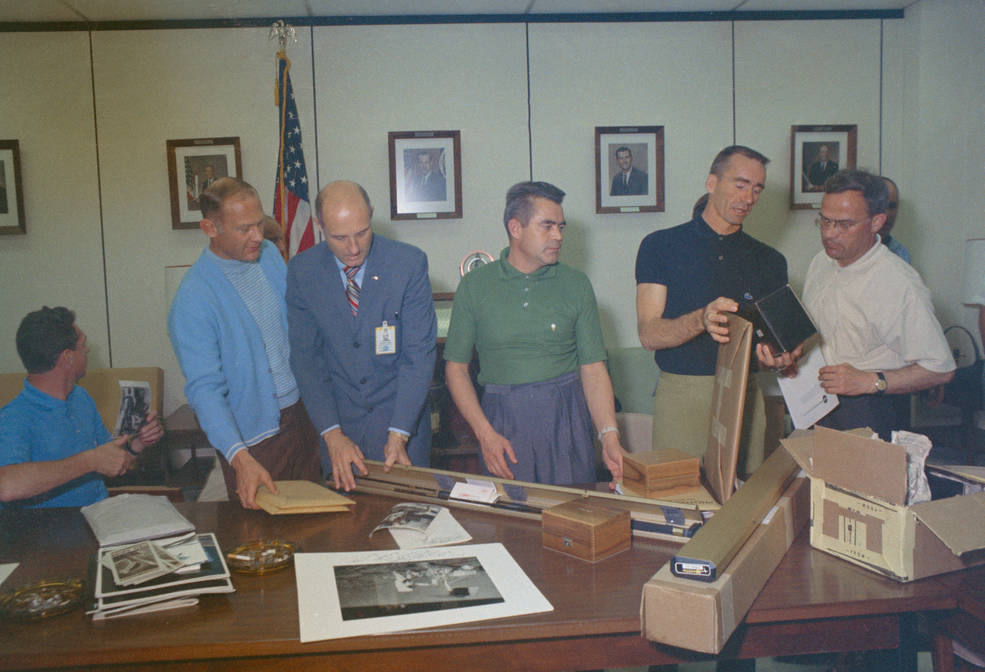
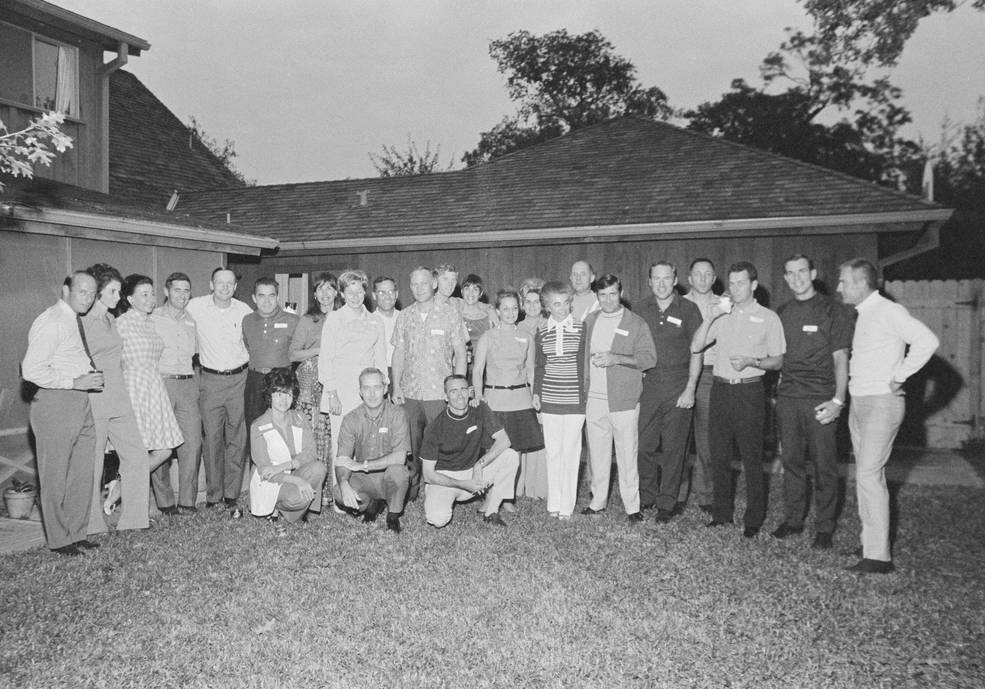
Left: Exchanging gifts at the Manned Spacecraft Center in Houston are
Vitali I. Sevastyanov, left, Edwin E. “Buzz” Aldrin, Thomas P. Stafford,
Andriyan G. Nikolayev, R. Walter Cunningham, and an unidentified
interpreter. Right: Informal gathering of astronauts at the home of NASA
astronaut James A. McDivitt to honor Nikolayev and Sevastyanov.
They departed Houston on Oct. 24, bound for Los Angeles. In Pasadena, they toured the California Institute of Technology (Caltech), where they saw a hypersonic wind tunnel and a laser laboratory. At NASA’s Jet Propulsion Laboratory, Director William H. Pickering introduced the cosmonauts to the press, toured them through the center, and hosted a reception in their honor. They also visited Disneyland in Anaheim, California, where they received Mickey Mouse watches from the character himself and took a simulated trip to the Moon.
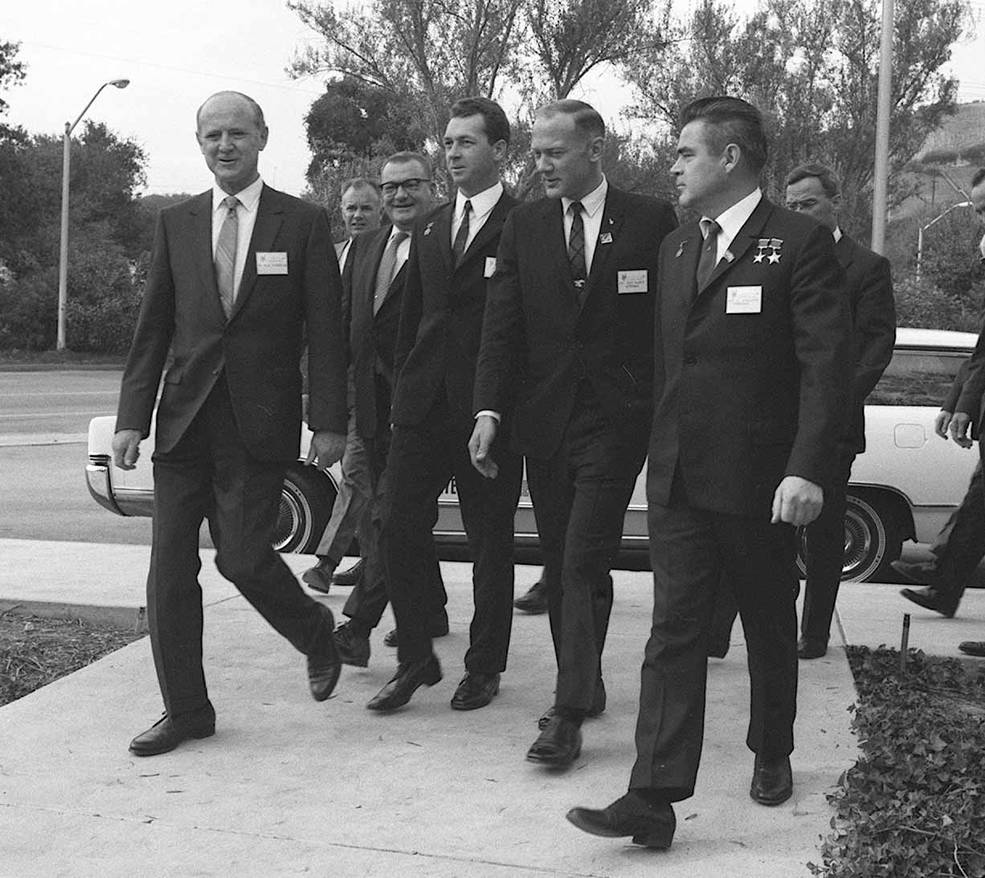
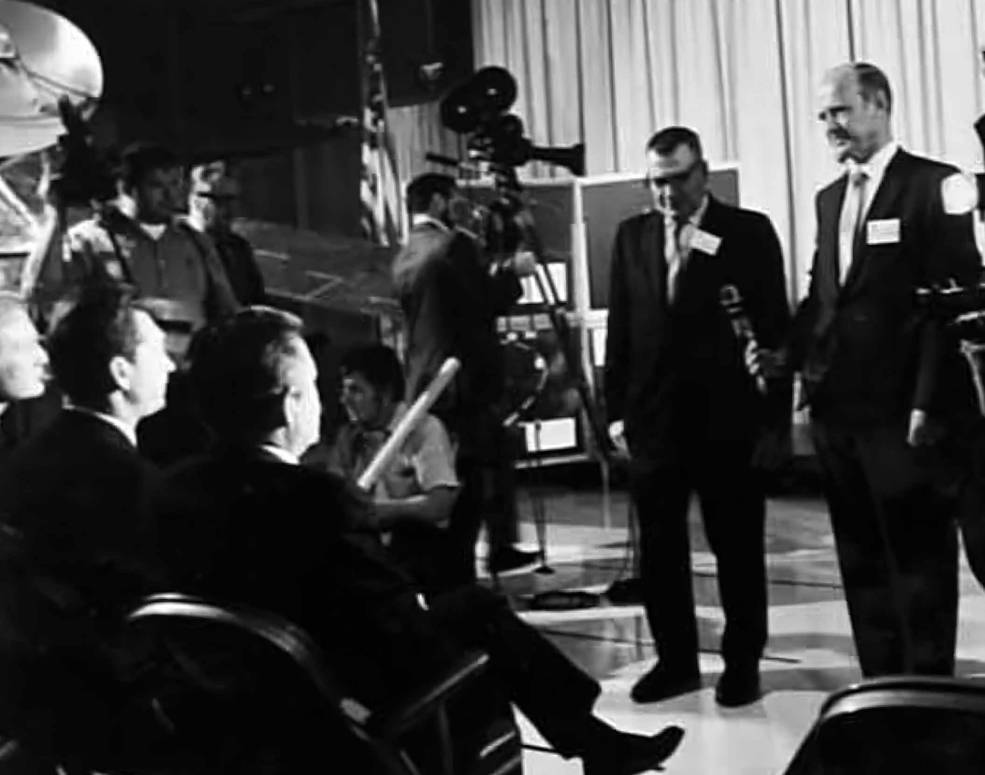
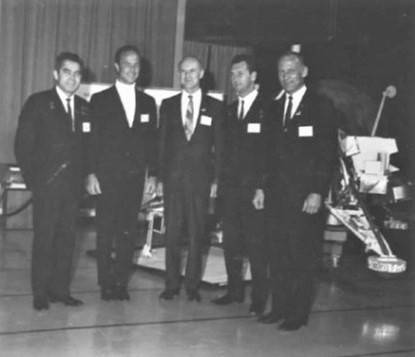
Left: Director of NASA’s Jet Propulsion Laboratory (JPL) William H. Pickering, left, begins the tour of the facility with Vitali I. Sevastyanov, Edwin E. “Buzz” Aldrin, and Andriyan G. Nikolayev. Middle: Pickering, standing, introduces Sevastyanov, seated at left, and Nikolayev to the audience at JPL. Right: Nikolayev, left, NASA astronaut M. Scott Carpenter, Pickering, Sevastyanov, and Aldrin standing in front of a model of a Surveyor robotic lunar lander.
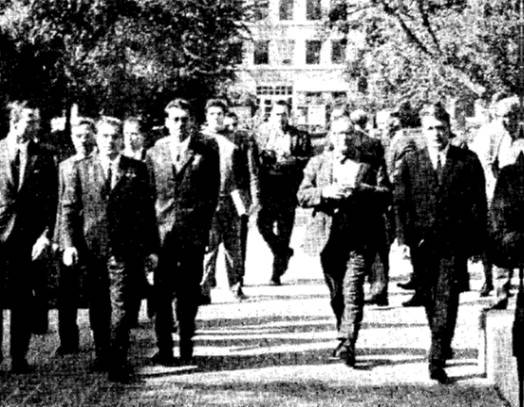
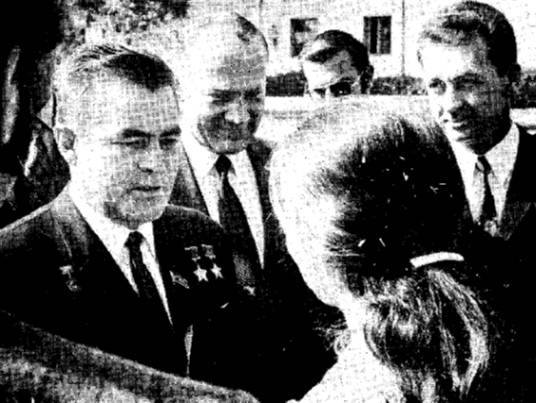
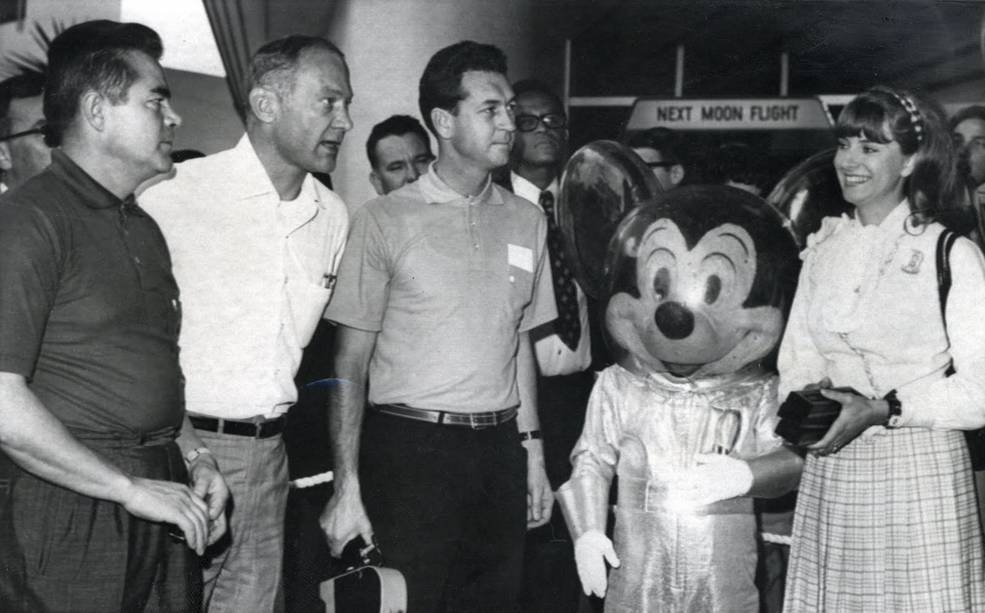
Left: Andriyan G. Nikolayev, Vitali I. Sevastyanov, Edwin E. “Buzz” Aldrin and their entourage touring the campus of the California Institute of Technology (Caltech). Photo credit: The California Tech. Middle: Nikoalyev, Aldrin, and Sevastyanov chatting with a Caltech student. Photo credit: The California Tech. Right: Nikolayev, left, Aldrin, and Sevastyanov with Mickey Mouse and Disney tour guide Kathy Burke at Disneyland in Anaheim, California.
Traveling to the San Francisco Bay area on Oct. 26, they landed at Moffett Field and toured NASA’s Ames Research Center in California’s Silicon Valley, where Director Hans M. Mark greeted them. Nikolayev, Sevastyanov, and Aldrin addressed several hundred assembled Ames employees then toured a new flight simulator for advanced aircraft and a high-speed wind tunnel with a scale model of a proposed NASA space shuttle vehicle. Their tour of Ames complete, they motorcaded to San Francisco for a meeting with Mayor Joseph L. Alioto.
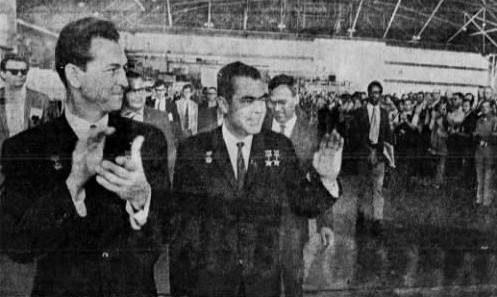
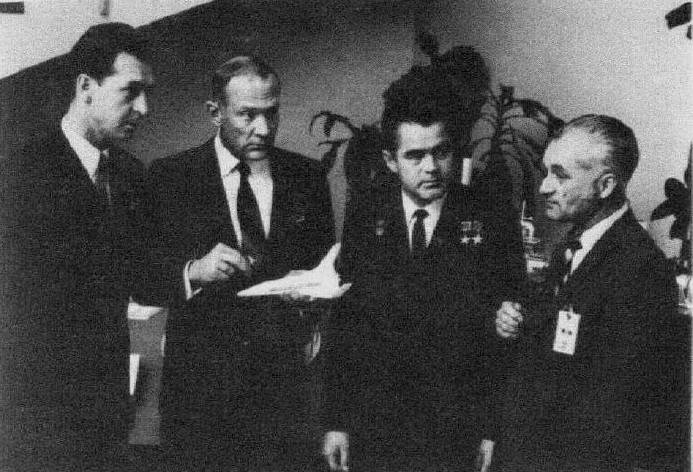
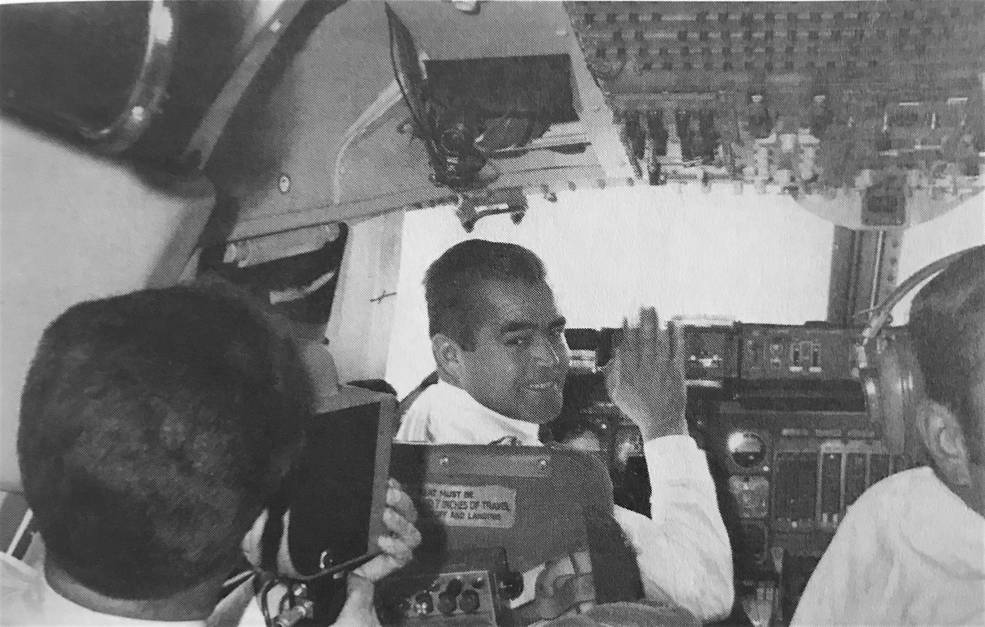
Left: Vitali I. Sevastyanov, left, and Andriyan G. Nikolayev greet employees at NASA’s Ames Research Center in California’s Silicon Valley. Photo credit: San Francisco Examiner. Middle: Sevastyanov, left, Edwin E. “Buzz” Aldrin, and Nikolayev discuss a model of a space shuttle with Chief of the Space Shuttle Office at Ames Victor I. Stevens. Right: In Seattle, Nikolayev, center, at the controls of a Boeing-747 during take-off as Sevastyanov, left, films the occasion.
The next stop on their goodwill tour was Seattle. At the Boeing aircraft plant, they not only toured a Boeing 747 but took turns flying the jumbo jet. Nikolayev, a fighter pilot with no experience flying multi-engine aircraft, took the controls for take-off, Sevastyanov handled level flight, and Aldrin brought the plane in for a landing. Afterward, Seattle Mayor Wesley C. Uhlman treated them to Russian dumplings and tea. On Oct. 27, they flew from Seattle to New York, where the next day, Mayor John V. Lindsey met with them. They visited the New York Stock Exchange and after a reception hosted by the Association of Stock Exchange Firms, they boarded their flight back to Moscow.
While Nikolayev and Sevastyanov toured the United States, a NASA delegation led by MSC Director Robert R. Gilruth participated in two days of meetings in Moscow to discuss possible future cooperation in human spaceflight. That first step led to the Apollo-Soyuz joint docking in space less than five years later.
With special thanks to Brian C. Odom, historian at NASA’s Marshall Space Flight Center, Erik M. Conway, historian at NASA’s Jet Propulsion Laboratory, and James N. Anderson, historian at NASA’s Ames Research Center, for significant contributions to this article.


























